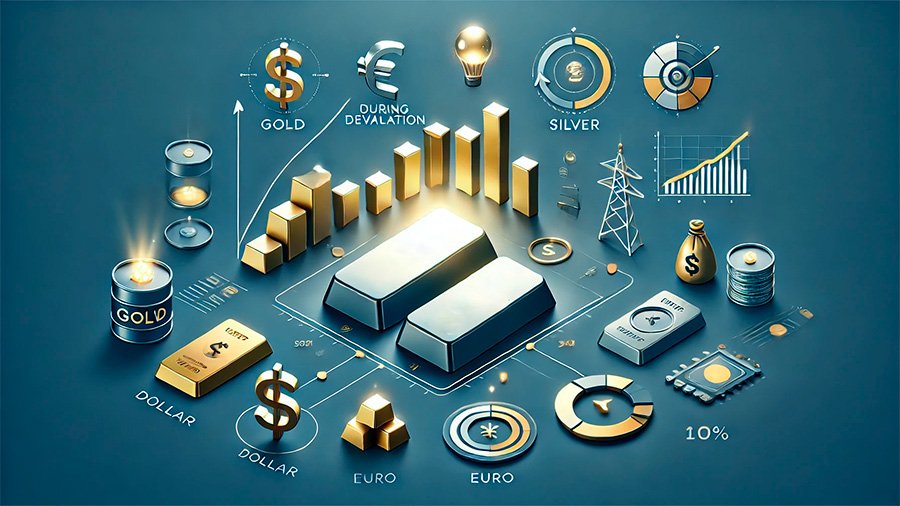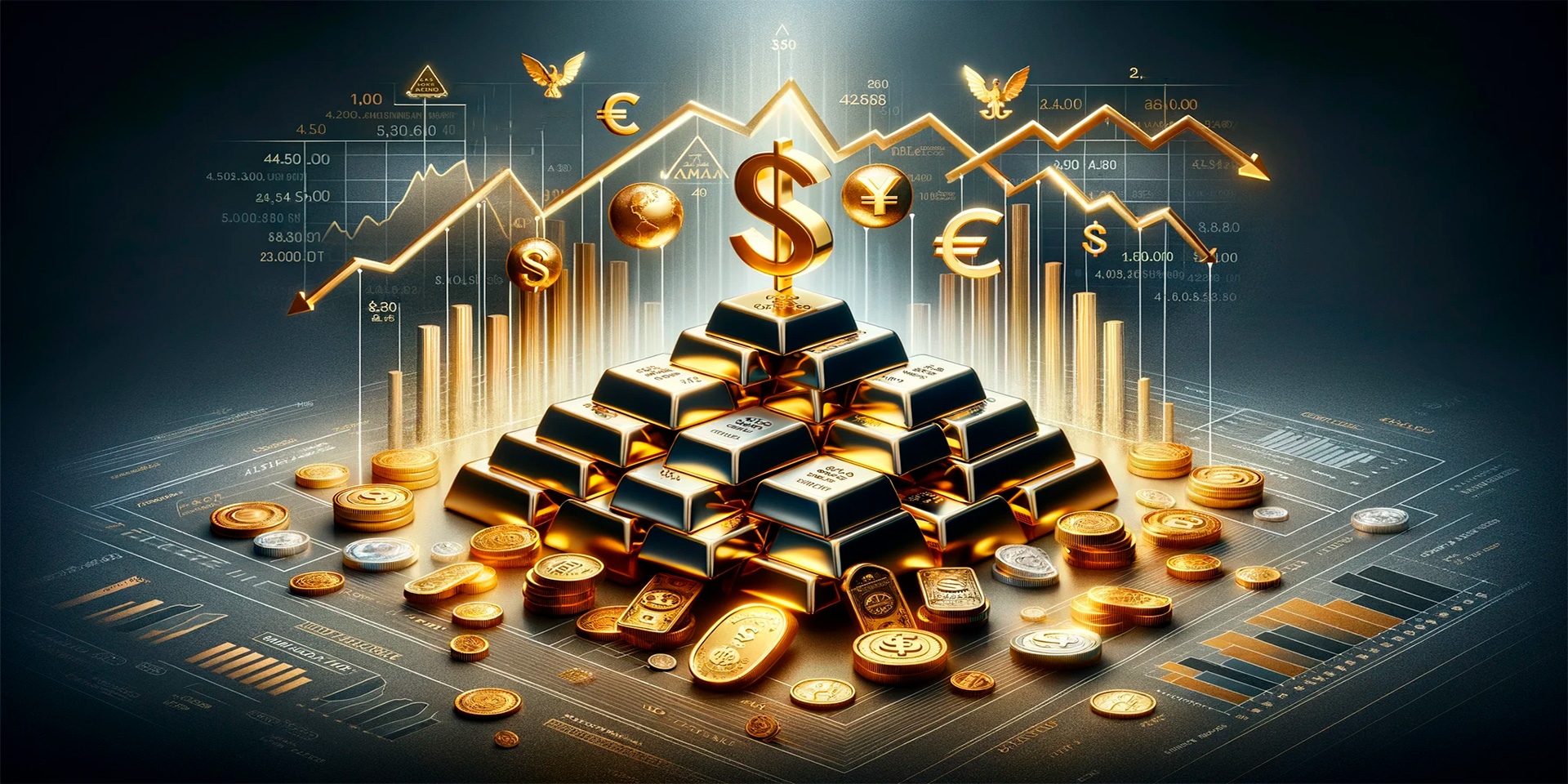In times of economic uncertainty, currency devaluation often leads to a loss of purchasing power, eroding the value of savings and investments. This is where precious metals like gold and silver play a critical role. Known for their historical significance as stores of value, these metals have maintained their worth through periods of hyperinflation, currency crises, and financial instability. This article explores how gold and silver preserve value when fiat currencies lose their purchasing power and why they are considered safe-haven assets in times of economic distress.
Understanding Currency Devaluation
Currency devaluation occurs when the value of a country’s currency falls relative to other currencies, often due to inflation, government policies, or market forces. When a currency is devalued, the cost of goods and services increases, and the purchasing power of consumers declines. This can lead to a range of economic challenges, including higher living costs, decreased savings value, and increased debt burdens. During such times, fiat currencies—government-issued currencies not backed by a physical commodity—can lose their purchasing power, making it harder for individuals and businesses to maintain financial stability.
1. Causes of Currency Devaluation
Several factors contribute to currency devaluation, including inflation, monetary policies, and global economic conditions.
Key causes of currency devaluation:
- Inflation: When a country experiences high inflation, the value of its currency declines because the purchasing power of the currency is reduced, leading to higher prices for goods and services.
- Monetary policies: Central banks may engage in actions such as printing more money or lowering interest rates to stimulate economic activity, which can inadvertently lead to currency devaluation.
- Global economic shifts: Trade imbalances, political instability, and changes in international demand for a country’s goods and services can also cause currency values to fluctuate or decline.

How Gold and Silver Preserve Value
Gold and silver are often viewed as “hard assets” because they have intrinsic value, meaning their worth is not dependent on the performance of any currency or financial system. As physical commodities, their value is influenced by supply and demand rather than the policies of governments or central banks. These metals have been used as stores of value for thousands of years, and during periods of currency devaluation, they tend to retain or even increase in value, making them a secure asset for preserving wealth.
1. The Intrinsic Value of Gold and Silver
Unlike fiat currencies, which are subject to inflation and government policies, the value of gold and silver is primarily driven by their limited supply and wide usage across various industries. As finite resources, they cannot be easily devalued through inflationary measures, making them a stable asset during economic instability.
Why gold and silver are considered intrinsic assets:
- Scarcity: Both gold and silver are finite resources, and their availability is limited, which supports their value over time. Unlike paper currencies, which can be printed at will, gold and silver are mined from the earth and require significant effort and resources to extract.
- Industrial and cultural demand: Gold and silver are used in a wide range of industries, including electronics, jewelry, medicine, and renewable energy. This broad demand helps sustain their value in global markets, even during times of economic instability.
- Historical store of value: Throughout history, gold and silver have been used as a medium of exchange and a measure of wealth. Their enduring value is rooted in centuries of cultural and economic significance.
2. Gold and Silver as Hedging Tools
During periods of currency devaluation, investors often turn to gold and silver as a hedge against inflation and a means of preserving wealth. When fiat currencies lose value, the purchasing power of assets like stocks, bonds, and real estate can decline. Gold and silver, however, have a reputation for holding their value and often increase in price as demand for safe-haven assets rises.
How gold and silver act as hedges:
- Protection against inflation: As the cost of living rises due to inflation, gold and silver tend to appreciate in value, helping to preserve purchasing power and reduce the impact of rising prices.
- Currency diversification: By investing in gold and silver, individuals and institutions can diversify their holdings away from currencies, reducing exposure to currency risk and protecting against devaluation.
- Rising demand in times of crisis: As fiat currencies lose value, investors flock to gold and silver, driving up their prices. This makes them a reliable asset in times of uncertainty, offering an effective means of safeguarding wealth.

Why Gold and Silver Perform Well During Currency Devaluation
Gold and silver have proven time and time again to be reliable assets during periods of economic distress. The historical trend shows that these metals tend to perform well when fiat currencies are under pressure, as their value is not tied to the policies of any single government or central bank.
1. Gold’s Performance During Financial Crises
Gold has historically been one of the top performers during financial crises and times of economic uncertainty. For instance, during the global financial crisis of 2008, gold prices surged as investors sought refuge from falling stock markets and unstable currencies. Similarly, during periods of hyperinflation, such as in Zimbabwe and Venezuela, gold retained its value while local currencies collapsed.
Gold’s role during financial crises:
- Safe-haven demand: When markets are volatile, investors rush to gold as a safe-haven asset, driving up its price.
- Increased buying from central banks: Central banks often increase their gold reserves during times of economic instability, further supporting gold’s price and demand.
- Long-term store of value: Gold has remained an effective store of value for centuries, making it a trusted asset in times of uncertainty.
2. Silver as a Complementary Asset
Silver, often referred to as “gold’s little brother,” shares many of the same properties but has unique characteristics that make it attractive during currency devaluation periods. While gold is often considered a more stable asset, silver has higher volatility and can see more dramatic price swings, offering opportunities for investors seeking higher returns during economic crises.
Why silver is a valuable asset:
- Lower price barrier: Silver’s lower price compared to gold makes it more accessible for individual investors who want to protect their wealth in times of financial distress.
- Industrial demand: Silver’s use in industries like electronics, solar energy, and healthcare supports its long-term value, even when it’s not experiencing significant price surges.
- Hedge against inflation: Like gold, silver serves as a hedge against inflation, rising in value as fiat currencies lose purchasing power.
How to Invest in Gold and Silver During Times of Currency Devaluation
Investing in gold and silver is a popular strategy for protecting wealth during times of currency devaluation. There are several ways to gain exposure to these precious metals, each with its own set of benefits and risks.
1. Physical Gold and Silver
Purchasing physical gold and silver is the most direct way to invest in these metals. Investors can buy bullion bars, coins, or rounds, which are widely available through online dealers and local precious metal shops. Physical metals offer the benefit of being tangible assets that can be stored securely in vaults or at home.
2. Precious Metals ETFs and Mutual Funds
Exchange-traded funds (ETFs) and mutual funds that track the price of gold and silver provide an easy and liquid way to gain exposure to precious metals without having to buy and store physical assets. These funds often track the price of gold and silver or invest in mining companies that produce these metals.
3. Mining Stocks
Investing in precious metal mining stocks offers exposure to the performance of mining companies. These stocks can offer significant growth potential, especially when the prices of gold and silver rise. However, they also come with risks tied to the performance of individual companies and the mining sector in general.
Conclusion
Gold and silver have long been recognized as safe-haven assets that preserve value during times of currency devaluation. When fiat currencies lose purchasing power due to inflation or economic turmoil, gold and silver offer a stable store of value, providing investors with a way to safeguard their wealth. Whether through physical assets, ETFs, or mining stocks, precious metals remain essential tools for diversifying investment portfolios and protecting against the risks associated with currency instability. As global economies continue to face challenges, the role of gold and silver as a hedge against financial crises will remain crucial for maintaining financial security.

